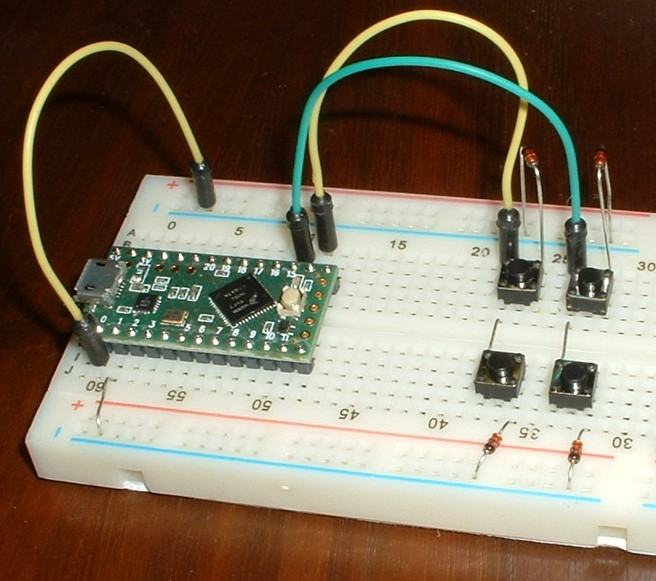5.2 KiB
Tutorial 3a - multi-layer keyboard
When you finish this tutorial you will be able to be able to modify a multi-layer keybrd sketch to write your very own multi-layer keyboard firmware.
Multi-layer nomenclature
layers - are key bindings provided by the keyboard firmware. For example,
- The classic IBM PC keyboard has one layer.
- Many compact keyboards have an additional Fn layer.
- The Neo layout has 6 layers.
layer id - is an integer used to identify a layer.
active layer - is the layer currently used by the keyboard.
layer scheme - is a system for changing the active layer while typing (a single-layer scheme does not change layers).
A simple multi-layer keybrd sketch
The keybrd_3a_multi-layer.ino sketch is for a simple two-layer keyboard. It will run on the basic breadboard keyboard described in tutorial_1_breadboard_keyboard.md.
Read the sketch annotations to understand how multi-layer keyboards work. The sketch uses three layer-scheme classes:
- LayerState
- Code_LayerHold
- Key_LayeredKeysArray
The internal workings of these three classes are revealed in the next section.
Pseudo code for simple layer scheme
The following pseudo code is of three keybrd library classes. It has just enough detail to show the internal workings of layer schemes.
Key_Layer objects change the active layer when pressed. The "layer" variable is a layer id number. When a Key_Layer object is pressed, it tells LayerState to update the active layer.
class Key_Layer
{
int layer;
LayerState& refLayerState;
press() { refLayerState.setActiveLayer(layer); }
};
LayerState objects keep track of the active layer. A LayerState's activeLayer is always up to date.
class LayerState
{
int activeLayer;
setActiveLayer(int layer) { activeLayer = layer; }
getActiveLayer() { return activeLayer; }
};
Key_LayeredKeysArray objects contain an array of keys, one key for each layer. Key_LayeredKeysArray use layer ids as array indexes. When a Key_LayeredKeysArray object is pressed, it gets the active layer from LayerState, and sends the corresponding key.
class Key_LayeredKeysArray
{
Key** ptrsKeys; //array of Key pointers, one Key pointer per layer
LayerState& refLayerState;
press() { layer = refLayerState.getActiveLayer();
ptrsKeys[layer]->press(); }
};
Dependency diagram
+-----------+
| Key_Layer |
+-----------+
|
|setActiveLayer()
|
v
+------------+
| LayerState |
+------------+
^
|
|getActiveLayer()
|
+----------------------+
| Key_LayeredKeysArray |
+----------------------+
Layer-scheme classes
There are several layer scheme-classes to choose from. You can view all the class definitions in the keybrd library.
Key_Layer classes include:
- Code_LayerHold
- Code_LayerLock
A basic LayerState class is:
- LayerState
Key_Layered classes include:
- Key_LayeredKeysArray
- Code_LayeredScSc
- Code_LayeredCodeSc
- Code_LayeredCodeCode
The basic LayerState provided by the keybrd library is sufficient for implementing ordinary layer schemes. For experimental layer schemes, you would need to create a custom LayerState class, and possibly Key_Layer and Key_Layered custom layer classes as well.
Single-layer Codes
Most Code objects only have one scancode or code. Example single-layer Code classes include:
- Code_Sc
- Code_ScS
- Code_ScNS
- Code_Shift
- Code_LayerHold
- Code_LayerLock
Exercises
- Modify the keybrd_3_multi-layer.ino sketch to use two Code_LayerLock objects.
| Layout | 0 | 1 |
|---|---|---|
| 0 | a 1 | b 2 |
| 1 | layer0 | layer1 |

keybrd tutorial by Wolfram Volpi is licensed under a Creative Commons Attribution 4.0 International License.
Permissions beyond the scope of this license may be available at https://github.com/wolfv6/keybrd/issues/new.
